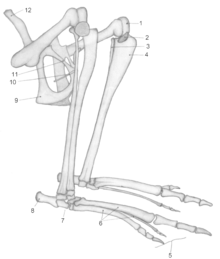- Epipubic bone
-
Epipubic bones are a pair of bones projecting forward from the pelvic bones of modern marsupials and of some fossil mammals: multituberculates, monotremes, and even basal eutherians (the ancestors of placental mammals).[1]
In modern marsupials the epipubic bones are often called "marsupial bones" because they support the mother's pouch ("marsupium" is Latin for "pouch"), but their presence on other groups of mammals indicates that this was not their original function, which some researchers think was to assist locomotion by supporting some of the muscles that flex the thigh.[2]
The epipubic bones were first described in 1698 but their functions have remained unresolved. It has been suggested[3] that they form part of a kinetic linkage stretching from the femur on one side to the ribs on the opposite side. This linkage is formed by a series of muscles: each epipubic bone is connected to the femur by the pectineus muscle, and to the ribs and vertebrae by the pyramidalis, rectus abdominis, and external and internal obliques. The epipubic bones act as levers to stiffen the trunk.
See also
References
- ^ Novacek, M.J.; Rougier, G.W.; Wible, J.R.; McKenna, M.C.; Dashzeveg, D; Horovitz, I (1997). "Epipubic bones in eutherian mammals from the late Cretaceous of Mongolia". Nature 389 (6650): 440–1. doi:10.1038/39020. PMID 9333234.
- ^ White, T.D. (August 9, 1989). "An analysis of epipubic bone function in mammals using scaling theory". Journal of Theoretical Biology 139 (3): 343–57. doi:10.1016/S0022-5193(89)80213-9. PMID 2615378.
- ^ Reilly SM, White TD. (2003-01-17). "Hypaxial motor patterns and the function of epipubic bones in primitive mammals". Science 299 (5605): 400–2. doi:10.1126/science.1074905. PMID 12532019.
Categories:- Mammal anatomy
Wikimedia Foundation. 2010.

